Drug Detail:Lidocaine (local) (monograph) (Medically reviewed)
Drug Class:
Lidocaine Description
Lidocaine hydrochloride injection, USP solution contain lidocaine hydrochloride, USP which is chemically designated as acetamide, 2-(diethylamino)-N-(2,6-dimethylphenyl)-, monohydrochloride and has the molecular wt. 270.8. Lidocaine hydrochloride, USP (C14H22N2O•HCl) has the following structural formula:
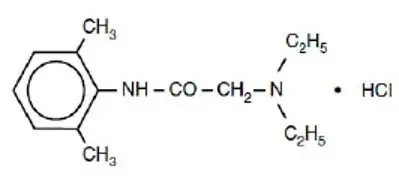
Lidocaine - Clinical Pharmacology
Pharmacokinetics and Metabolism
The plasma binding of lidocaine HCl is dependent on drug concentration, and the fraction bound decreases with increasing concentration. At concentrations of 1 to 4 mcg of free base per mL 60 to 80 percent of lidocaine HCl is protein bound. Binding is also dependent on the plasma concentration of the alpha-1-acid glycoprotein.
Lidocaine HCl crosses the blood-brain and placental barriers, presumably by passive diffusion.
Lidocaine HCl is metabolized rapidly by the liver, and metabolites and unchanged drug are excreted by the kidneys. Biotransformation includes oxidative N-dealkylation, ring hydroxylation, cleavage of the amide linkage, and conjugation. N-dealkylation, a major pathway of biotransformation, yields the metabolites monoethylglycinexylidide and glycinexylidide. The pharmacological/toxicological actions of these metabolites are similar to, but less potent than, those of lidocaine HCl. Approximately 90% of lidocaine HCl administered is excreted in the form of various metabolites, and less than 10% is excreted unchanged. The primary metabolite in urine is a conjugate of 4-hydroxy-2,6- dimethylaniline.
The elimination half-life of lidocaine HCl following an intravenous bolus injection is typically 1.5 to 2 hours. Because of the rapid rate at which lidocaine HCl is metabolized, any condition that affects liver function may alter lidocaine HCl kinetics. The half-life may be prolonged two-fold or more in patients with liver dysfunction.
Renal dysfunction does not affect lidocaine HCl kinetics but may increase the accumulation of metabolites.
Factors such as acidosis and the use of CNS stimulants and depressants affect the CNS levels of lidocaine HCl required to produce overt systemic effects. Objective adverse manifestations become increasingly apparent with increasing venous plasma levels above 6 mcg free base per mL. In the rhesus monkey arterial blood levels of 18 to 21 mcg/mL have been shown to be threshold for convulsive activity.
Warnings
Methemoglobinemia
Signs of methemoglobinemia may occur immediately or may be delayed some hours after exposure, and are characterized by a cyanotic skin discoloration and/or abnormal coloration of the blood. Methemoglobin levels may continue to rise; therefore, immediate treatment is required to avert more serious central nervous system and cardiovascular adverse effects, including seizures, coma, arrhythmias, and death. Discontinue lidocaine hydrochloride and any other oxidizing agents. Depending on the severity of the signs and symptoms, patients may respond to supportive care, i.e., oxygen therapy, hydration. A more severe clinical presentation may require treatment with methylene blue, exchange transfusion, or hyperbaric oxygen.
Intra-articular infusions of local anesthetics following arthroscopic and other surgical procedures is an unapproved use, and there have been post-marketing reports of chondrolysis in patients receiving such infusions. The majority of reported cases of chondrolysis have involved the shoulder joint; cases of gleno-humeral chondrolysis have been described in pediatric and adult patients following intra-articular infusions of local anesthetics with and without epinephrine for periods of 48 to 72 hours. There is insufficient information to determine whether shorter infusion periods are not associated with these findings. The time of onset of symptoms, such as joint pain, stiffness and loss of motion can be variable, but may begin as early as the 2ndmonth after surgery. Currently, there is no effective treatment for chondrolysis; patients who experienced chondrolysis have required additional diagnostic and therapeutic procedures and some required arthroplasty or shoulder replacement.
To avoid intravascular injection, aspiration should be performed before the local anesthetic solution is injected. The needle must be repositioned until no return of blood can be elicited by aspiration. Note, however, that the absence of blood in the syringe does not guarantee that intravascular injection has been avoided.
Anaphylactic reactions may occur following administration of lidocaine hydrochloride (see ADVERSE REACTIONS).
In the case of severe reaction, discontinue the use of the drug.
Precautions
General
Resuscitative equipment, oxygen, and other resuscitative drugs should be available for immediate use (see WARNINGS and ADVERSE REACTIONS). The lowest dosage that results in effective anesthesia should be used to avoid high plasma levels and serious adverse effects. Syringe aspirations should also be performed before and during each supplemental injection when using indwelling catheter techniques. During the administration of epidural anesthesia, it is recommended that a test dose be administered initially and that the patient be monitored for central nervous system toxicity and cardiovascular toxicity, as well as for signs of unintended intrathecal administration, before proceeding. When clinical conditions permit, consideration should be given to employing local anesthetic solutions that contain epinephrine for the test dose because circulatory changes compatible with epinephrine may also serve as a warning sign of unintended intravascular injection. An intravascular injection is still possible even if aspirations for blood are negative. Repeated doses of lidocaine HCl may cause significant increases in blood levels with each repeated dose because of slow accumulation of the drug or its metabolites. Tolerance to elevated blood levels varies with the status of the patient. Debilitated, elderly patients, acutely ill patients, and children should be given reduced doses commensurate with their age and physical condition. Lidocaine HCl should also be used with caution in patients with severe shock or heart block.
Lumbar and caudal epidural anesthesia should be used with extreme caution in persons with the following conditions: existing neurological disease, spinal deformities, septicemia, and severe hypertension.
Local anesthetic solutions containing a vasoconstrictor should be used cautiously and in carefully circumscribed quantities in areas of the body supplied by end arteries or having otherwise compromised blood supply. Patients with peripheral vascular disease and those with hypertensive vascular disease may exhibit exaggerated vasoconstrictor response. Ischemic injury or necrosis may result. Preparations containing a vasoconstrictor should be used with caution in patients during or following the administration of potent general anesthetic agents, since cardiac arrhythmias may occur under such conditions.
Careful and constant monitoring of cardiovascular and respiratory (adequacy of ventilation) vital signs and the patient's state of consciousness should be accomplished after each local anesthetic injection. It should be kept in mind at such times that restlessness, anxiety, tinnitus, dizziness, blurred vision, tremors, depression or drowsiness may be early warning signs of central nervous system toxicity.
Since amide-type local anesthetics are metabolized by the liver, lidocaine hydrochloride injection should be used with caution in patients with hepatic disease. Patients with severe hepatic disease, because of their inability to metabolize local anesthetics normally, are at greater risk of developing toxic plasma concentrations. Lidocaine hydrochloride injection should also be used with caution in patients with impaired cardiovascular function since they may be less able to compensate for functional changes associated with the prolongation of A-V conduction produced by these drugs.
Many drugs used during the conduct of anesthesia are considered potential triggering agents for familial malignant hyperthermia. Since it is not known whether amide-type local anesthetics may trigger this reaction and since the need for supplemental general anesthesia cannot be predicted in advance, it is suggested that a standard protocol for the management of malignant hyperthermia should be available. Early unexplained signs of tachycardia, tachypnea, labile blood pressure and metabolic acidosis may precede temperature elevation. Successful outcome is dependent on early diagnosis, prompt discontinuance of the suspect triggering agent(s) and institution of treatment, including oxygen therapy, indicated supportive measures and dantrolene (consult dantrolene sodium intravenous package insert before using).
Proper tourniquet technique, as described in publications and standard textbooks, is essential in the performance of intravenous regional anesthesia. Solutions containing epinephrine or other vasoconstrictors should not be used for this technique.
Lidocaine HCl should be used with caution in persons with known drug sensitivities. Patients allergic to para-aminobenzoic acid derivatives (procaine, tetracaine, benzocaine, etc) have not shown cross-sensitivity to lidocaine HCl.
Information for Patients
Inform patients that use of local anesthetics may cause methemoglobinemia, a serious condition that must be treated promptly. Advise patients or caregivers to seek immediate medical attention if they or someone in their care experience the following signs or symptoms: pale, gray, or blue colored skin (cyanosis); headache; rapid heart rate; shortness of breath; lightheadedness; or fatigue.
Drug/Laboratory Test Interactions
Patients who are administered local anesthetics are at increased risk of developing methemoglobinemia when concurrently exposed to the following drugs, which could include other local anesthetics:
Examples of Drugs Associated with Methemoglobinemia:
| Class
| Examples
|
| Nitrates/Nitrites | nitric oxide, nitroglycerin, nitroprusside, nitrous oxide |
| Local anesthetics | articaine, benzocaine, bupivacaine, lidocaine, mepivacaine, prilocaine, procaine, ropivacaine, tetracaine |
| Antineoplastic agents | cyclophosphamide, flutamide, hydroxyurea, ifosfamide, rasburicase |
| Antibiotics | dapsone, nitrofurantoin, para-aminosalicylic acid, sulfonamides |
| Antimalarials | chloroquine, primaquine |
| Anticonvulsants | Phenobarbital, phenytoin, sodium valproate |
| Other drugs | acetaminophen, metoclopramide, quinine, sulfasalazine |
Labor and Delivery
Maternal hypotension has resulted from regional anesthesia. Local anesthetics produce vasodilation by blocking sympathetic nerves. Elevating the patient's legs and positioning her on her left side will help prevent decreases in blood pressure.
The fetal heart rate also should be monitored continuously, and electronic fetal monitoring is highly advisable.
Epidural, spinal, paracervical, or pudendal anesthesia may alter the forces of parturition through changes in uterine contractility or maternal expulsive efforts. In one study, paracervical block anesthesia was associated with a decrease in the mean duration of first stage labor and facilitation of cervical dilation. However, spinal and epidural anesthesia have also been reported to prolong the second stage of labor by removing the parturient's reflex urge to bear down or by interfering with motor function. The use of obstetrical anesthesia may increase the need for forceps assistance.
The use of some local anesthetic drug products during labor and delivery may be followed by diminished muscle strength and tone for the first day or two of life. The long-term significance of these observations is unknown. Fetal bradycardia may occur in 20 to 30 percent of patients receiving paracervical nerve block anesthesia with the amide- type local anesthetics and may be associated with fetal acidosis. Fetal heart rate should always be monitored during paracervical anesthesia. The physician should weigh the possible advantages against risks when considering a paracervical block in prematurity, toxemia of pregnancy, and fetal distress. Careful adherence to recommended dosage is of the utmost importance in obstetrical paracervical block. Failure to achieve adequate analgesia with recommended doses should arouse suspicion of intravascular or fetal intracranial injection. Cases compatible with unintended fetal intracranial injection of local anesthetic solution have been reported following intended paracervical or pudendal block or both. Babies so affected present with unexplained neonatal depression at birth, which correlates with high local anesthetic serum levels, and often manifest seizures within six hours. Prompt use of supportive measures combined with forced urinary excretion of the local anesthetic has been used successfully to manage this complication.
Case reports of maternal convulsions and cardiovascular collapse following use of some local anesthetics for paracervical block in early pregnancy (as anesthesia for elective abortion) suggest that systemic absorption under these circumstances may be rapid. The recommended maximum dose of each drug should not be exceeded. Injection should be made slowly and with frequent aspiration. Allow a 5-minute interval between sides.
Adverse Reactions/Side Effects
Central Nervous System
Drowsiness following the administration of lidocaine HCl is usually an early sign of a high blood level of the drug and may occur as a consequence of rapid absorption.
Allergic
There have been no reports of cross sensitivity between lidocaine hydrochloride and procainamide or between lidocaine hydrochloride and quinidine.
Neurologic
In the practice of caudal or lumbar epidural block, occasional unintentional penetration of the subarachnoid space by the catheter may occur. Subsequent adverse effects may depend partially on the amount of drug administered subdurally. These may include spinal block of varying magnitude (including total spinal block), hypotension secondary to spinal block, loss of bladder and bowel control, and loss of perineal sensation and sexual function. Persistent motor, sensory and/or autonomic (sphincter control) deficit of some lower spinal segments with slow recovery (several months) or incomplete recovery have been reported in rare instances when caudal or lumbar epidural block has been attempted. Backache and headache have also been noted following use of these anesthetic procedures.
There have been reported cases of permanent injury to extraocular muscles requiring surgical repair following retrobulbar administration.
Overdosage
Management of Local Anesthetic Emergencies
The first step in the management of convulsions, as well as underventilation or apnea due to unintended subarachnoid injection of drug solution, consists of immediate attention to the maintenance of a patent airway and assisted or controlled ventilation with oxygen and a delivery system capable of permitting immediate positive airway pressure by mask. Immediately after the institution of these ventilatory measures, the adequacy of the circulation should be evaluated, keeping in mind that drugs used to treat convulsions sometimes depress the circulation when administered intravenously. Should convulsions persist despite adequate respiratory support, and if the status of the circulation permits, small increments of an ultra-short acting barbiturate (such as thiopental or thiamylal) or a benzodiazepine (such as diazepam) may be administered intravenously. The clinician should be familiar, prior to the use of local anesthetics, with these anticonvulsant drugs. Supportive treatment of circulatory depression may require administration of intravenous fluids and, when appropriate, a vasopressor as directed by the clinical situation (e.g., ephedrine).
If not treated immediately, both convulsions and cardiovascular depression can result in hypoxia, acidosis, bradycardia, arrhythmias and cardiac arrest. Underventilation or apnea due to unintentional subarachnoid injection of local anesthetic solution may produce these same signs and also lead to cardiac arrest if ventilatory support is not instituted. If cardiac arrest should occur, standard cardiopulmonary resuscitative measures should be instituted.
Endotracheal intubation, employing drugs and techniques familiar to the clinician, may be indicated, after initial administration of oxygen by mask, if difficulty is encountered in the maintenance of a patent airway or if prolonged ventilatory support (assisted or controlled) is indicated.
Dialysis is of negligible value in the treatment of acute overdosage with lidocaine HCl.
The oral LD50 of lidocaine HCl in non-fasted female rats is 459 (346 to 773) mg/kg (as the salt) and 214 (159 to 324) mg/kg (as the salt) in fasted female rats.
Lidocaine Dosage and Administration
There have been adverse event reports of chondrolysis in patients receiving intra-articular infusions of local anesthetics following arthroscopic and other surgical procedures. Lidocaine hydrochloride injection is not approved for this use (see WARNINGS and DOSAGE AND ADMINISTRATION).
These recommended doses serve only as a guide to the amount of anesthetic required for most routine procedures. The actual volumes and concentrations to be used depend on a number of factors such as type and extent of surgical procedure, depth of anesthesia and degree of muscular relaxation required, duration of anesthesia required, and the physical condition of the patient. In all cases the lowest concentration and smallest dose that will produce the desired result should be given. Dosages should be reduced for children and for the elderly and debilitated patients and patients with cardiac and/or liver disease.
The onset of anesthesia, the duration of anesthesia and the degree of muscular relaxation are proportional to the volume and concentration (i.e., total dose) of local anesthetic used. Thus, an increase in volume and concentration of lidocaine hydrochloride injection will decrease the onset of anesthesia, prolong the duration of anesthesia, provide a greater degree of muscular relaxation and increase the segmental spread of anesthesia. However, increasing the volume and concentration of lidocaine hydrochloride injection may result in a more profound fall in blood pressure when used in epidural anesthesia. Although the incidence of side effects with lidocaine HCl is quite low, caution should be exercised when employing large volumes and concentrations, since the incidence of side effects is directly proportional to the total dose of local anesthetic agent injected.
Epidural Anesthesia
1% without epinephrine 2 mL single-dose vials
1% without epinephrine 5 mL single-dose vials
2% without epinephrine 2 mL single-dose vials
2% without epinephrine 5 mL single-dose vials
Although these solutions are intended specifically for epidural anesthesia, they may also be used for infiltration and peripheral nerve block, provided they are employed as single dose units. These solutions contain no bacteriostatic agent.
In epidural anesthesia, the dosage varies with the number of dermatomes to be anesthetized (generally 2 to 3 mL of the indicated concentration per dermatome).
Caudal and Lumbar Epidural Block
Patients on beta blockers may not manifest changes in heart rate, but blood pressure monitoring can detect an evanescent rise in systolic blood pressure. Adequate time should be allowed for onset of anesthesia after administration of each test dose. The rapid injection of a large volume of lidocaine hydrochloride injection through the catheter should be avoided, and, when feasible, fractional doses should be administered.
In the event of the known injection of a large volume of local anesthetic solution into the subarachnoid space, after suitable resuscitation and if the catheter is in place, consider attempting the recovery of drug by draining a moderate amount of cerebrospinal fluid (such as 10 mL) through the epidural catheter.
MAXIMUM RECOMMENDED DOSAGES
Adults
The maximum recommended dose per 90 minute period of lidocaine hydrochloride for paracervical block in obstetrical patients and non-obstetrical patients is 200 mg total. One half of the total dose is usually administered to each side. Inject slowly, five minutes between sides (see also discussion of paracervical block in PRECAUTIONS).
For intravenous regional anesthesia, the dose administered should not exceed 4 mg/kg in adults.
Children
In order to guard against systemic toxicity, the lowest effective concentration and lowest effective dose should be used at all times. In some cases it will be necessary to dilute available concentrations with 0.9% sodium chloride injection in order to obtain the required final concentration.
NOTE: Parenteral drug products should be inspected visually for particulate matter and discoloration prior to administration whenever the solution and container permit. The Injection is not to be used if its color is pinkish or darker than slightly yellow or if it contains a precipitate.
Table 1: Recommended Dosages
| Lidocaine Hydrochloride Injection (without epinephrine)
|
|||
| Procedure | Conc (%) | Vol (mL) | Total Dose (mg) |
| Infiltration | |||
| Percutaneous | 0.5 or 1 | 1 to 60 | 5 to 300 |
| Intravenous regional | 0.5 | 10 to 60 | 50 to 300 |
| Peripheral Nerve Blocks, e.g., | |||
| Brachial | 1.5 | 15 to 20 | 225 to 300 |
| Dental | 2 | 1 to 5 | 20 to 100 |
| Intercostal | 1 | 3 | 30 |
| Paravertebral | 1 | 3 to 5 | 30 to 50 |
| Pudendal (each side) | 1 | 10 | 100 |
| Paracervical | |||
| Obstetrical analgesia (each side) | 1 | 10 | 100 |
| Sympathetic Nerve Blocks, e.g., | |||
| Cervical (stellate ganglion) | 1 | 5 | 50 |
| Lumbar | 1 | 5 to 10 | 50 to 100 |
| Central Neural Blocks | |||
| Epidural* | |||
| Thoracic | 1 | 20 to 30 | 200 to 300 |
| Lumbar | 1 | 25 to 30 | 250 to 300 |
| Analgesia | 1.5 | 15 to 20 | 225 to 300 |
| Anesthesia | 2 | 10 to 15 | 200 to 300 |
| Caudal | |||
| Obstetrical analgesia | 1 | 20 to 30 | 200 to 300 |
| Surgical anesthesia | 1.5 | 15 to 20 | 225 to 300 |
*Dose determined by number of dermatomes to be anesthetized (2 to 3 mL/dermatome).
THE ABOVE SUGGESTED CONCENTRATIONS AND VOLUMES SERVE ONLY AS A GUIDE. OTHER VOLUMES AND CONCENTRATIONS MAY BE USED PROVIDED THE TOTAL MAXIMUM RECOMMENDED DOSE IS NOT EXCEEDED.
HOW SUPPLIED
Preservative-Free
1% (20 mg/2 mL) (10 mg/mL):
Carton of 1 Single-dose 2 mL Vial NDC 70756-640-82
Carton of 10 Single-dose 2 mL Vials NDC 70756-640-10
Carton of 25 Single-dose 2 mL Vials NDC 70756-640-25
1% (50 mg/5 mL) (10 mg/mL):
Carton of 1 Single-dose 5 mL Vial NDC 70756-641-85
Carton of 10 Single-dose 5 mL Vials NDC 70756-641-10
Carton of 25 Single-dose 5 mL Vials NDC 70756-641-25
2% (40 mg/2 mL) (20 mg/mL):
Carton of 1 Single-dose 2 mL Vial NDC 70756-642-82
Carton of 10 Single-dose 2 mL Vials NDC 70756-642-10
Carton of 25 Single-dose 2 mL Vials NDC 70756-642-25
2% (100 mg/5 mL) (20 mg/mL):
Carton of 1 Single-dose 5 mL Vial NDC 70756-643-85
Carton of 10 Single-dose 5 mL Vials NDC 70756-643-10
Carton of 25 Single-dose 5 mL Vials NDC 70756-643-25
Discard unused portion.
All solutions should be stored at 20° to 25°C (68° to 77°F) [See USP Controlled Room Temperature].
Protect from light.
To report SUSPECTED ADVERSE REACTIONS, contact Lifestar Pharma LLC at 1-888-995-4337 or FDA at 1-800-FDA-1088 or www.fda.gov/medwatch.
Manufactured for:
Lifestar Pharma LLC
1200 MacArthur Blvd.
Mahwah, NJ 07430 USA
Made in India
Revised: August 2022, V-01
PACKAGE LABEL.PRINCIPAL DISPLAY PANEL
Lidocaine Hydrochloride Injection, USP
1%
20 mg per 2 mL
(10 mg per mL)
For Infiltration and Nerve Block Including Caudal and Epidural Use.
2 mL Single-Dose Vial
Rx Only
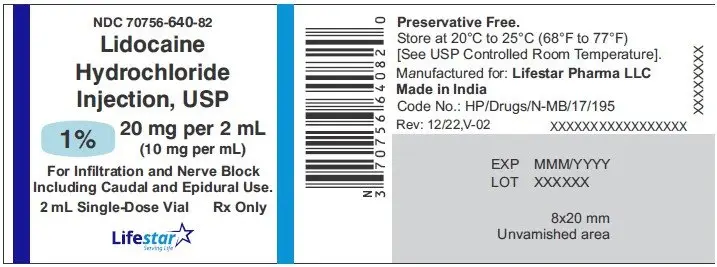
Lidocaine Hydrochloride Injection, USP
1%
20 mg per 2 mL
(10 mg per mL)
For Infiltration and Nerve Block Including Caudal and Epidural Use.
Preservative Free
2 mL Single-Dose Vial
Rx Only
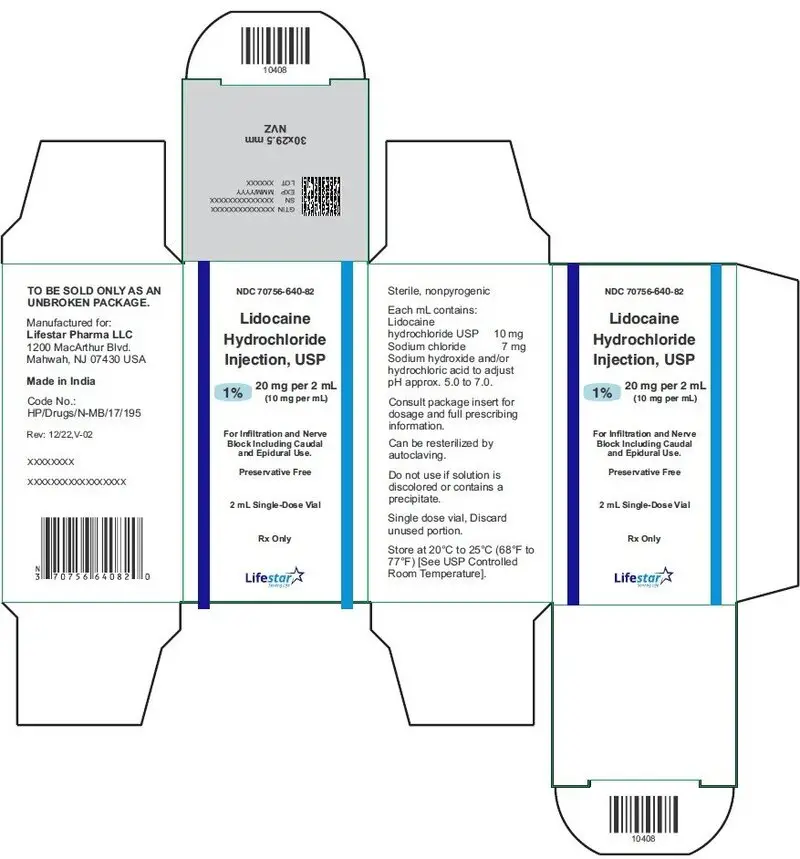
Lidocaine Hydrochloride Injection, USP
1%
20 mg per 2 mL
(10 mg per mL)
For Infiltration and Nerve Block Including Caudal and Epidural Use.
Preservative Free
10 x 2 mL Single-Dose Vials
Rx Only
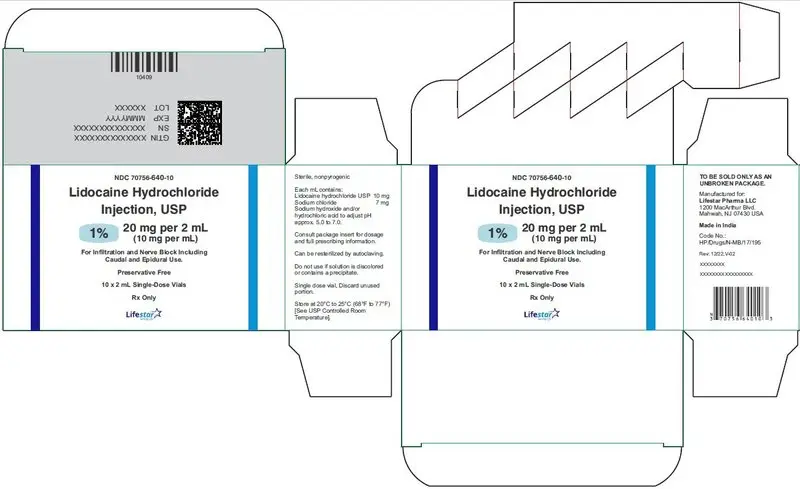
Lidocaine Hydrochloride Injection, USP
1%
20 mg per 2 mL
(10 mg per mL)
For Infiltration and Nerve Block Including Caudal and Epidural Use.
Preservative Free
25 x 2 mL Single-Dose Vials
Rx Only
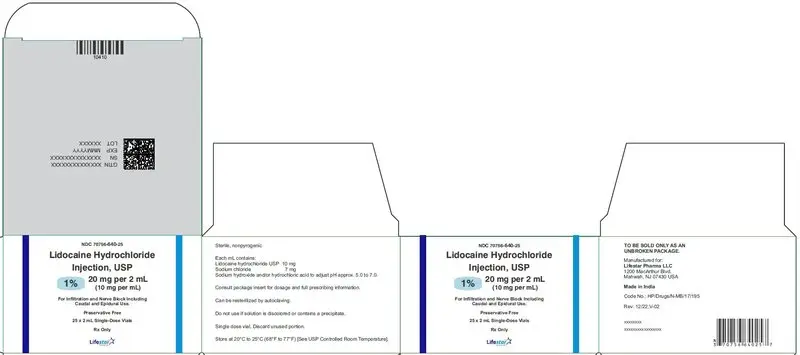
Lidocaine Hydrochloride Injection, USP
1%
50 mg per 5 mL
(10 mg per mL)
For Infiltration and Nerve Block Including Caudal and Epidural Use.
5 mL Single-Dose Vial
Rx Only
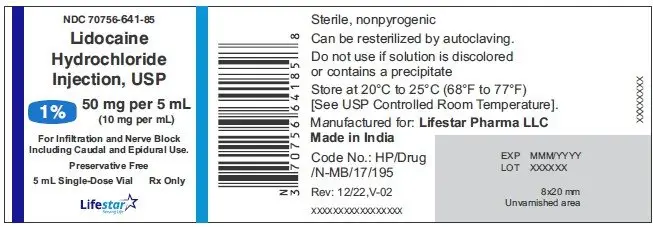
Lidocaine Hydrochloride Injection, USP
1%
50 mg per 5 mL
(10 mg per mL)
For Infiltration and Nerve Block Including Caudal and Epidural Use.
Preservative Free
5 mL Single-Dose Vial
Rx Only
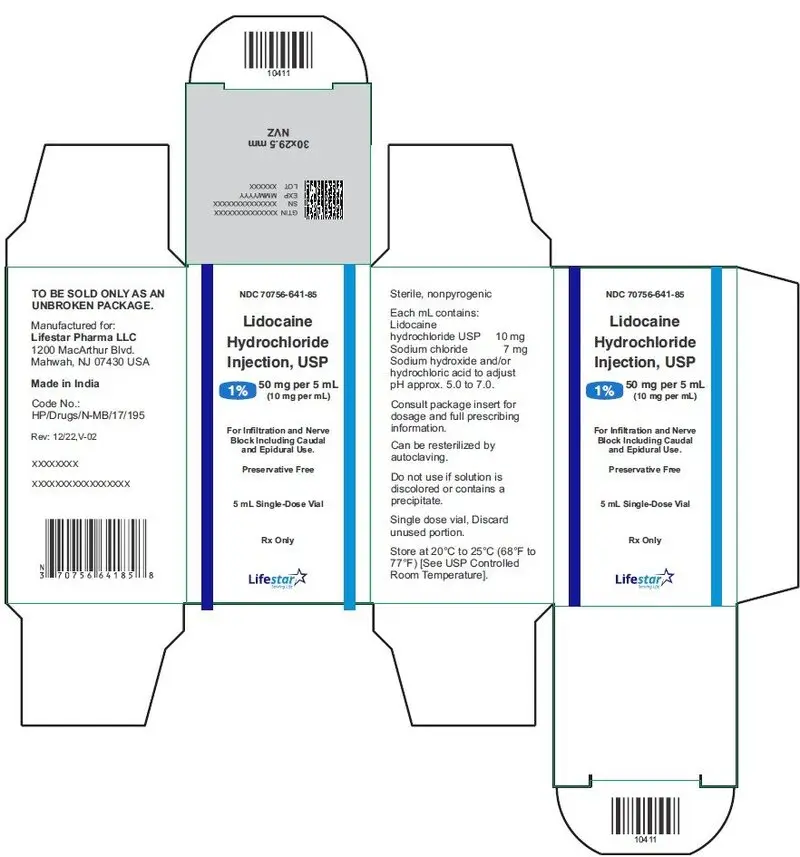
Lidocaine Hydrochloride Injection, USP
1%
50 mg per 5 mL
(10 mg per mL)
For Infiltration and Nerve Block Including Caudal and Epidural Use.
Preservative Free
10 x 5 mL Single-Dose Vials
Rx Only
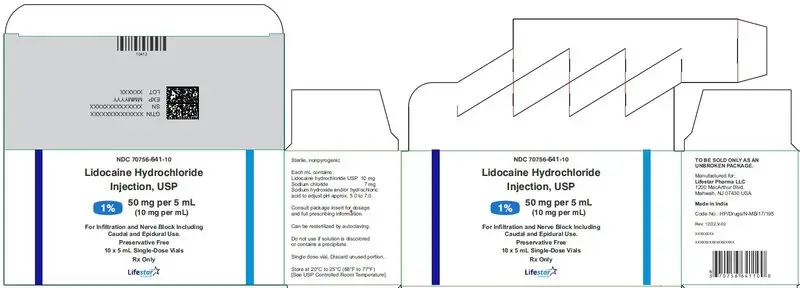
Lidocaine Hydrochloride Injection, USP
1%
50 mg per 5 mL
(10 mg per mL)
For Infiltration and Nerve Block Including Caudal and Epidural Use.
Preservative Free
25 x 5 mL Single-Dose Vials
Rx Only
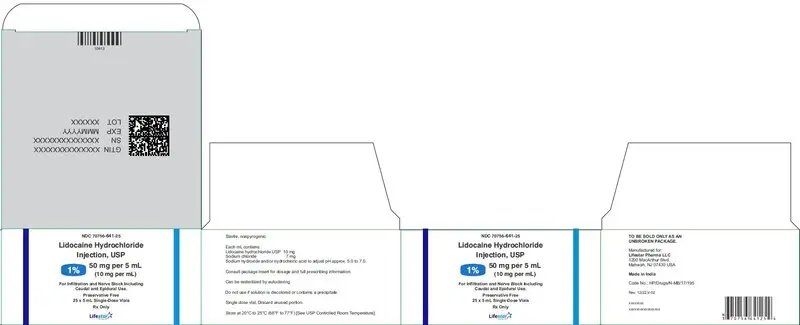
Lidocaine Hydrochloride Injection, USP
2%
40 mg per 2 mL
(20 mg per mL)
For Infiltration and Nerve Block Including Caudal and Epidural Use.
2 mL Single-Dose Vial
Rx Only
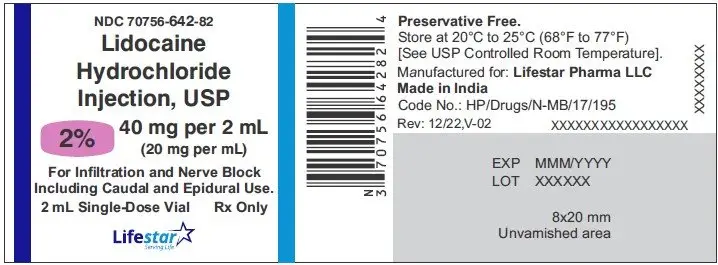
Lidocaine Hydrochloride Injection, USP
2%
40 mg per 2 mL
(20 mg per mL)
For Infiltration and Nerve Block Including Caudal and Epidural Use.
Preservative Free
2 mL Single-Dose Vial
Rx Only
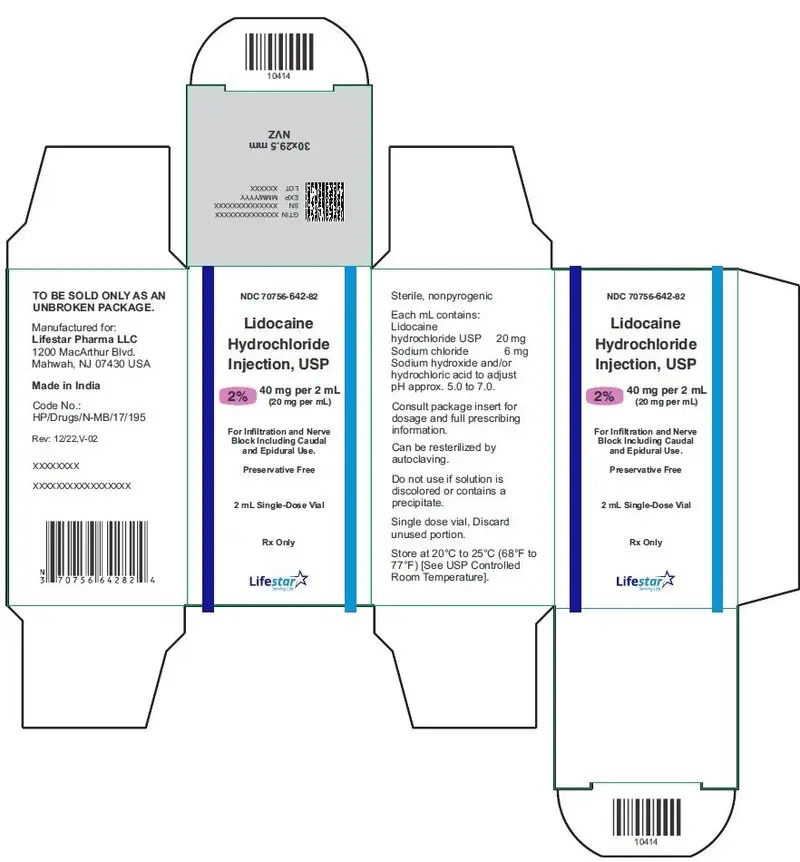
Lidocaine Hydrochloride Injection, USP
2%
40 mg per 2 mL
(20 mg per mL)
For Infiltration and Nerve Block Including Caudal and Epidural Use.
Preservative Free
10 x 2 mL Single-Dose Vials
Rx Only
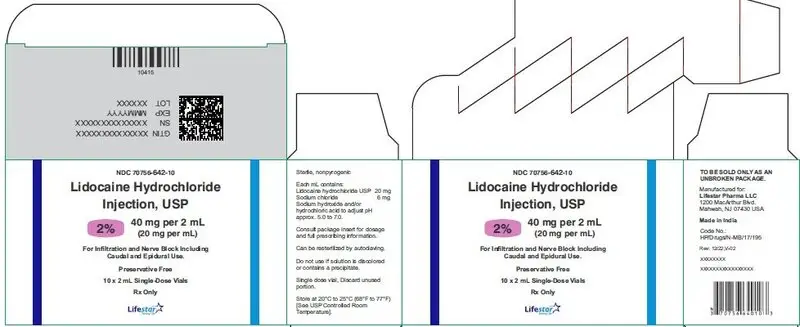
Lidocaine Hydrochloride Injection, USP
2%
40 mg per 2 mL
(20 mg per mL)
For Infiltration and Nerve Block Including Caudal and Epidural Use.
Preservative Free
25 x 2 mL Single-Dose Vials
Rx Only
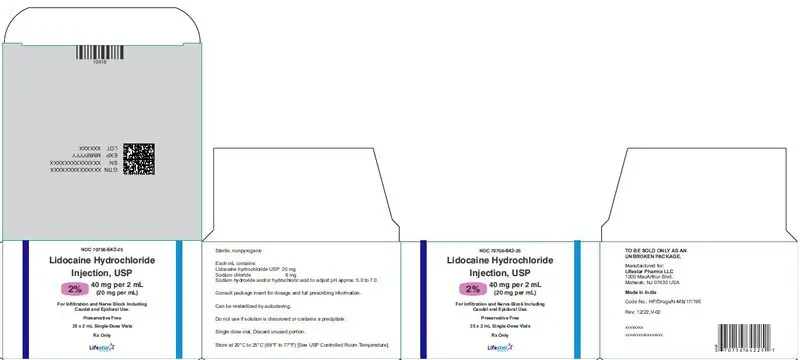
Lidocaine Hydrochloride Injection, USP
2%
100 mg per 5 mL
(20 mg per mL)
For Infiltration and Nerve Block Including Caudal and Epidural Use.
5 mL Single-Dose Vial
Rx Only
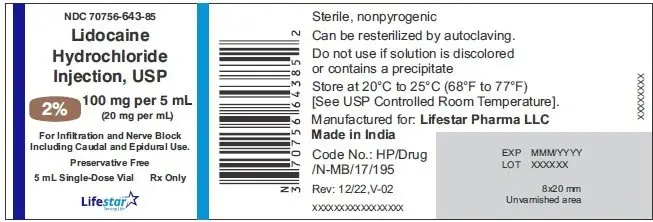
Lidocaine Hydrochloride Injection, USP
2%
100 mg per 5 mL
(20 mg per mL)
For Infiltration and Nerve Block Including Caudal and Epidural Use.
Preservative Free
5 mL Single-Dose Vial
Rx Only
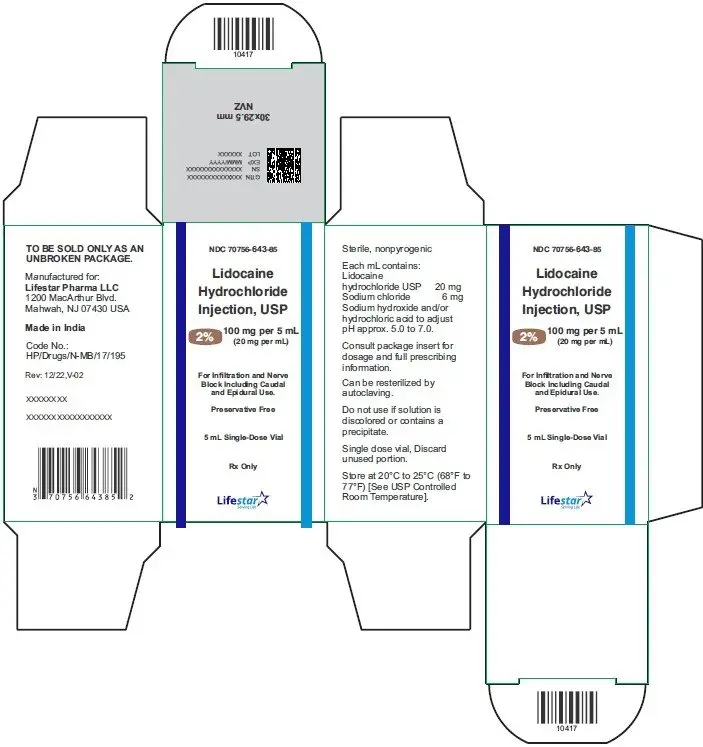
Lidocaine Hydrochloride Injection, USP
2%
100 mg per 5 mL
(20 mg per mL)
For Infiltration and Nerve Block Including Caudal and Epidural Use.
Preservative Free
10 x 5 mL Single-Dose Vials
Rx Only
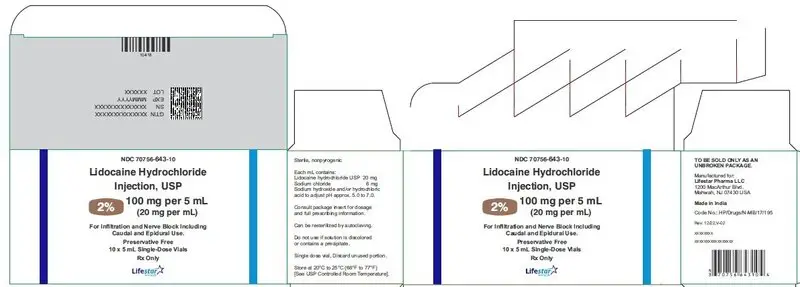
Lidocaine Hydrochloride Injection, USP
2%
100 mg per 5 mL
(20 mg per mL)
For Infiltration and Nerve Block Including Caudal and Epidural Use.
Preservative Free
25 x 5 mL Single-Dose Vials
Rx Only
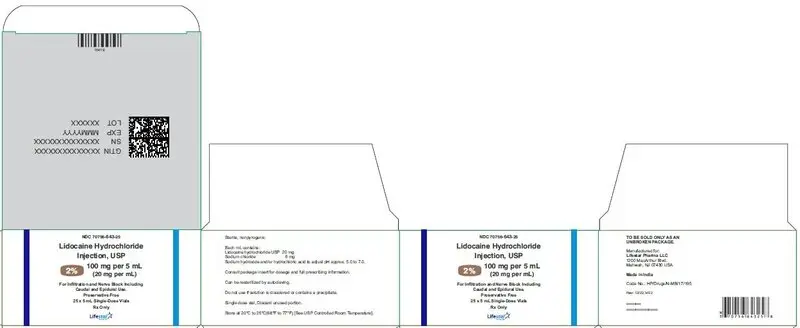
| LIDOCAINE HYDROCHLORIDE
lidocaine hydrochloride injection, solution |
||||||||||||||||||||||||||||||||||||||||
|
||||||||||||||||||||||||||||||||||||||||
|
||||||||||||||||||||||||||||||||||||||||
|
||||||||||||||||||||||||||||||||||||||||
|
||||||||||||||||||||||||||||||||||||||||
|
||||||||||||||||||||||||||||||||||||||||
| LIDOCAINE HYDROCHLORIDE
lidocaine hydrochloride injection, solution |
||||||||||||||||||||||||||||||||||||||||
|
||||||||||||||||||||||||||||||||||||||||
|
||||||||||||||||||||||||||||||||||||||||
|
||||||||||||||||||||||||||||||||||||||||
|
||||||||||||||||||||||||||||||||||||||||
|
||||||||||||||||||||||||||||||||||||||||
| LIDOCAINE HYDROCHLORIDE
lidocaine hydrochloride injection, solution |
||||||||||||||||||||||||||||||||||||||||
|
||||||||||||||||||||||||||||||||||||||||
|
||||||||||||||||||||||||||||||||||||||||
|
||||||||||||||||||||||||||||||||||||||||
|
||||||||||||||||||||||||||||||||||||||||
|
||||||||||||||||||||||||||||||||||||||||
| LIDOCAINE HYDROCHLORIDE
lidocaine hydrochloride injection, solution |
||||||||||||||||||||||||||||||||||||||||
|
||||||||||||||||||||||||||||||||||||||||
|
||||||||||||||||||||||||||||||||||||||||
|
||||||||||||||||||||||||||||||||||||||||
|
||||||||||||||||||||||||||||||||||||||||
|
||||||||||||||||||||||||||||||||||||||||
| Labeler - Lifestar Pharma LLC (080268943) |
| Registrant - Mankind Pharma Limited (915834068) |
| Establishment | |||
| Name | Address | ID/FEI | Business Operations |
|---|---|---|---|
| Mankind Pharma Limited | 916512493 | MANUFACTURE(70756-640, 70756-641, 70756-642, 70756-643) , ANALYSIS(70756-640, 70756-641, 70756-642, 70756-643) , PACK(70756-640, 70756-641, 70756-642, 70756-643) | |




